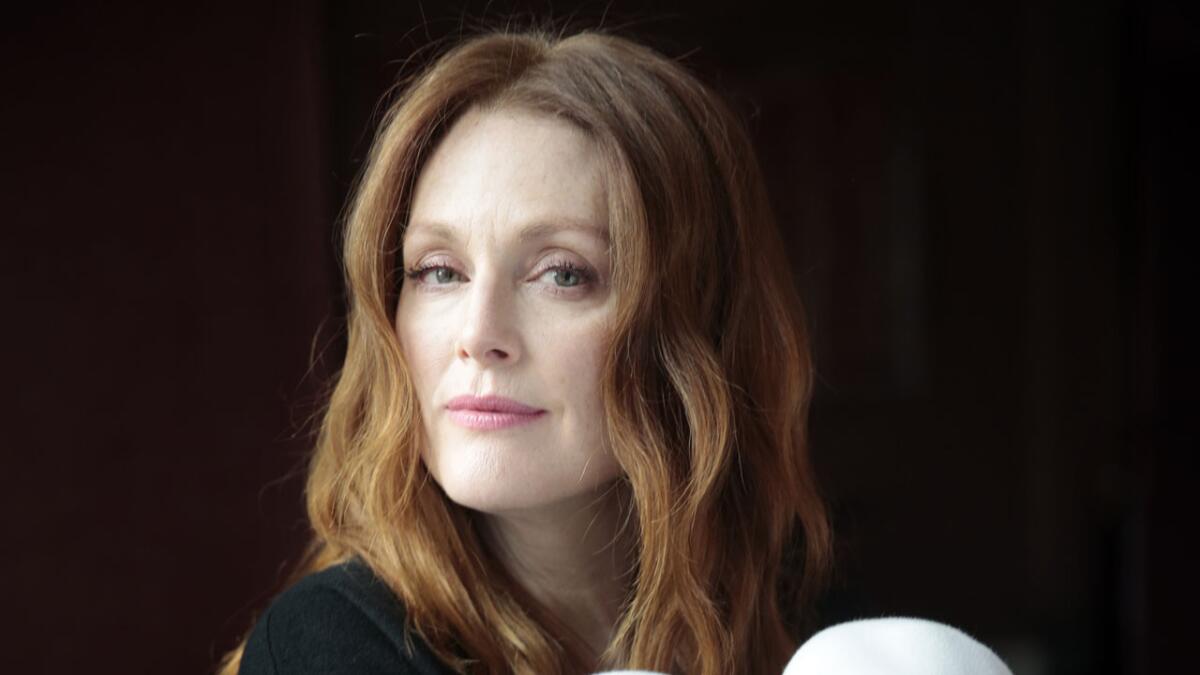Julianne Moore works to find the person inside the struggle

- Share via
Reporting from NEW YORK — For most actors playing fictional characters, role research tends to consist of watching a few similar movies, maybe reading a book or two. To prepare for her latest part as a middle-aged woman hit with a diagnosis of early-onset Alzheimer’s, Julianne Moore met with the head of the national Alzheimer’s Association, underwent a battery of tests and hung out with scores of patients suffering from the condition.
“I didn’t want it to be this general thing, where you just give this mannered performance of someone who has a disease,” Moore said on a recent morning, discussing her headlong preparations. “People think personalities get obliterated with Alzheimer’s. And I found people’s personalities come through loud and clear.”
Neurological disorders are nothing new on the big screen, and there have been as many characters as there are types of disease. But it’s rare to see a drama from the point of view of the Alzheimer’s patient who’s suffering through the changes — the encroaching forgetfulness, the creeping realization that everyday tasks, and words, are becoming disorientingly alien.
Adapted by directors Wash Westmoreland and Richard Glatzer from Lisa Genova’s popular novel, “Still Alice” follows a lead character — a successful Columbia University psychology professor and parent to three adult children — struggling to hang on to her previous life while, every day, the fog grows thicker. She tries to write a speech as vocabulary eludes her. She forgets her own actress daughter (Kristen Stewart) while backstage at the younger woman’s performance. She even writes instructions to her future, more enfeebled self.
Moore’s turn in “Still Alice,” which has her as a front-runner for the lead actress Oscar, is that uncommon big-screen performance--one that captures the cruelty of disease from the inside.
It didn’t come easy. After deciding to take on the role, she set out to meet as many Alzheimer’s suffers as she could. In those interactions with patients — the youngest was a chilling 49 — she saw flashes of their pre-diagnosis lives trying to peek through.
“It’s this man who was a bartender on Second Avenue, and he would say, ‘Come sit down’ and talk to you like he was still behind the bar. There was a woman who was a fashion model who was still showing me samples even though she couldn’t always remember them.”
Moore would soak in their personalities and jot down telling details, the kind that define most people’s lives but almost never appear in a show or film. There was, for instances, how patients used declarations instead of questions about their former selves. Or how they have trouble looking strangers in the eye. Or how a yellow highlighter becomes a key tool for an Alzheimer’s patient so they don’t read the same passage over and over.
She would then add bits to the performance that she learned in her research, and nix portions of the script that didn’t square with it. “I didn’t,” she said, “want to do anything in the movie I didn’t see in real life.” (Said Stewart, who has some of the more noteworthy scenes with Moore, “I’ve never seen someone straddle the technical side of what we do while maintaining this utterly boundless and surprising soul.”)
If Westmoreland and Glatzer were open to Moore’s suggestions, it was because the trio had formed a bond. In 2013, the directors Skyped with Moore, who lives in New York, to court her for the role. The group had spoken about a film the year before that didn’t pan out. But this new project had taken on added significance--Glatzer (he and Westmoreland are a husband-and-husband team) suffers from ALS and has endured a rapid decline in the past year. And though his disease is primarily physical and Alice’s mental, the story about a sudden and steady upending of a once-potent life was resonant.
“There are these enormous parallels in terms of the sense of the barriers between you and the world,” Westmoreland said. “You have to constantly struggle to push through, and there are new challenges every day as the disease moves forward. Those feelings all went into the direction and writing of the movie.” He added, “And we could hear the clock ticking.”
Moore felt their urgency. After agreeing to come aboard, she recruited former “30 Rock” costar Alec Baldwin, who had been asking her to find him a drama, to play Alice’s supportive but complicated husband. She then sought and was granted an intermission from her duties on the Atlanta set of the “Hunger Games: Mockingjay” films, where she was shooting her part as the revolution leader Alma Coin. In March she flew home to New York and shot the entirety of “Still Alice” — she is in all but one major scene — in a whip-snap three weeks.
The journey, however, was far from over. The movie premiered without a distributor at the Toronto International Film Festival in a low-profile slot, and there was little indication of where it would end up or when; when you star in a lot of independent productions, as Moore does, long-term certainty isn’t part of the deal.
Yet the Toronto premiere turned entire audiences into applauding, tear-streaked masses. Within a few days, Sony Pictures Classics had bought the film and agreed to put out the movie this season. On Monday — just about twelve weeks after the film was shown for the first time — Moore was accepting the Gotham Award for lead actress.
When the Golden Globes and Screen Actors Guild awards announce their lead actress nominations next week, she’s expected to be on that list too, and most pundits say she will not only be nominated but likely win an Oscar. It would be her first after four nominations without a win, over a five-year burst from 1998 to 2003.
“I’m not cool enough to say I pooh-pooh it all,” she said of her attitude toward awards season. “I wish I could say ‘Eh, whatever.’ I really do. But I’m not. I like a prize as much as anyone.”
(Moore said she knew she might have something different with “Alice” when she took her husband, the director Bart Freundlich, to a screening shortly before Toronto. “I heard a noise next to me at one point. I said, ‘Are you crying?,’” she said, her voice going into a high-pitched register it travels to when she gets incredulous. “I couldn’t believe it. He’s not a crier.”)
Moore has a no-nonsense, down-to-earth style that avoids many of the typical actor platitudes. (Her turn as a phony B-list actress in David Cronenberg’s upcoming “Maps to the Stars” is something of a sly joke.) She is prone to tossing off details about her kids’ schools, a New York sports bar she used to wait tables at and how she was “folding laundry at home” when the call came she had won a Cannes prize for “Maps.”
That quality has also helped Moore, who turned 54 this week, to become a cool den mother of sorts to a younger generation of actresses. She is frequently the subject of admiring, quote-happy tweets from Ellen Page, with whom she stars in the upcoming gay-rights drama “Freeheld,” and also exchanges social-media messages with her children. Stewart breaks her typically cool demeanor in an interview to show excitement about “Julie,” as the actress is known to friends.
Yet told that, at the same time, she has a reputation in Hollywood for feistiness, Moore looked taken aback for a second, made a joke about her red hair, then said: “I think I’m pretty detailed-oriented. I like everything thought out. I’m thorough. I’m not one of those seat-of-my-pants actors. If I ask someone a question on a movie and they say ‘I don’t know,’ I’ll ask, ‘Why don’t you know?’”
Though she said she chased down the part in “Mockingjay” because she liked the political allegory when her teenage kids brought the book home, she said she imagines that her usual heavy rotation of auteur and independent pieces, often with difficult characters, remained in the offing. Director and friend Todd Haynes — who worked with Moore on “Far from Heaven,” “Safe” and “I’m Not There” — noted in an email that the actress “couldn’t care a fig about her characters being ‘liked,’ and yet they are infinitely, profoundly sympathetic.”
“Alice” comes in a long line of parts of people undergoing crucibles — regular people in extraordinary circumstances, and the inverse. Moore can seem to revel in these kinds of characters, those whose struggles are interior, or at least not driven by simple narrative turns--the kinds of people, in short, some might describe as emotionally embattled.
“Oh, God, I think it says that on my Wikipedia page,” she said with a laugh when asked about it, acknowledging even so that she reads crowdsourced material. “I don’t know if that’s true. I like playing women dealing with their circumstances.”
She paused. “There’s a Zadie Smith line I always get wrong that says that people denigrate family movies as being less important, and ‘How can that be when it’s the most important narrative of our lives?’ I feel like I’m just playing regular people in relationships. I like those stories better than ‘Hey, I discovered Antarctica.’ Which actually has to do with somebody’s parents anyway.
“No one’s leading a typical life,” she added. “Everyone’s story is a big story.”
More to Read
Only good movies
Get the Indie Focus newsletter, Mark Olsen's weekly guide to the world of cinema.
You may occasionally receive promotional content from the Los Angeles Times.











